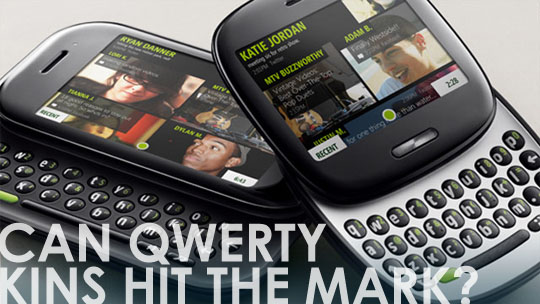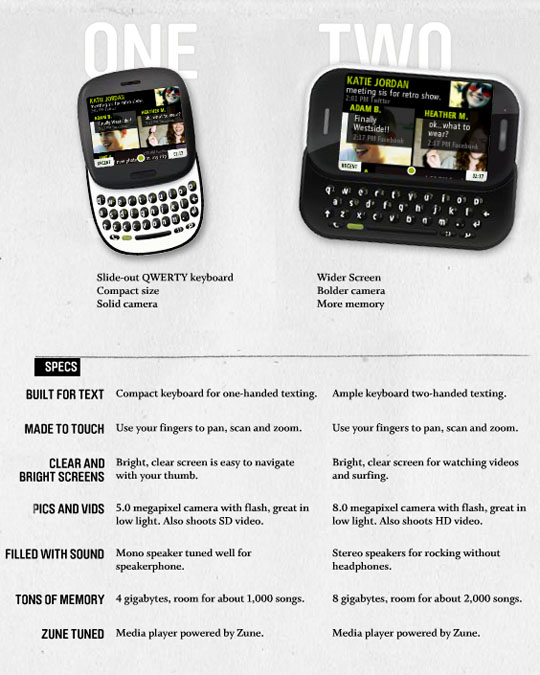Kin: Microsoft aims at mobile sociability
 After Microsoft unveiled its Project Pink as Kin there was a lot of speculation as to what it really meant, given the major noise Microsoft has been making about its other phone strategy, Windows Phone 7. The Kin phones and service are clearly targeted at a teen demographic, in the same way that Gossip Girl targets the teen demographic by portraying a lifestyle 99.9% of their audience will never achieve… you know… aspirational.
After Microsoft unveiled its Project Pink as Kin there was a lot of speculation as to what it really meant, given the major noise Microsoft has been making about its other phone strategy, Windows Phone 7. The Kin phones and service are clearly targeted at a teen demographic, in the same way that Gossip Girl targets the teen demographic by portraying a lifestyle 99.9% of their audience will never achieve… you know… aspirational.
The snide remarks aside, after taking a look at what Kin has to offer, and the pedigree behind it, the Kin phones might actually have some potential, if marketed right.
That pedigree is Microsoft’s 2008 acquisition of Danger, the makers of the Sidekick, which was a successful line until smartphones started to take off, and the last Sidekick tried to play within that market. What the Sidekick did well was IM and texting, with its flip out screen exposing a full QWERTY keyboard. Both the phones announced at the “It’s Time To Share” event, the Kin 1 and Kin 2, come with full keyboards, and the Kin 2 in particular appears to be a natural evolution of the Sidekick design, with touchscreen in tow. Also a natural evolution of the hardware? That the phones are being manufactured by Sharp, just as the Sidekicks were.
The Hardware
Both phones feature keyboards, touch screens and high resolution cameras, though the Kin 1 is clearly going to be the less expensive of the two. The Kin 1 is a smaller device with a square screen, 4 GB of storage and a slide up keyboard and a 5 megapixel camera. Think of a stubby Palm Pre and you’re on the right track. The Kin 2 appears to be a natural evolution of the Sidekick, with a slide out landscape keyboard, 8 GB of data, a larger 8 megapixel camera and a larger screen. The Kin 1 can shoot SD video, while the Kin 2 is capable of recording 720p video. In fact, both the phones include Nvidia Tegra processors, just like the Zune HD, though at this point they don’t run Zune apps. With a Tegra inside, but little in the way of 3D pizzazz, these phones should see exceptional battery life, well beyond that of your average smart phone.
It’s Really About The Software
The Kin team decided that instead of getting into the application business, it would be best to have the phones interact seamlessly with various social networks out of the box. This is what they are calling the Kin Loop, your home page that constantly updates feeds activities of your friends . For people used to smart phones and 3rd party applications, the social media focus of the Kin is really neither here nor there. What does make it noteworthy is the integration of both Facebook and Twitter (well, and Myspace too but does that still count?) into the OS itself.
The GUI itself appears to be a “light” version of Windows Phone 7, or an aggressively social version of the Zune HD. In fact, although the design is more flashy, the Kin Loop functions conceptually like the Home tiles of Windows Phone 7. Microsoft has also said that features on the phones will evolve as over-the-air updates become available, and they expect that over time, both Windows Phone 7 and Kin will see more shared features. This should come as no surprise, as according to various sources, the Kin phones at their core are running the same operating system as Windows Phone 7. In short, instead of fracturing their mobile strategy, the Kin brings integration, just to a target audience that wants something different out of its mobile devices.
The Kin is also evidence of Microsoft solidifying its Zune Marketplace as the entry point for media across their platforms, as the Kin phones feature the Zune media player, and will also support the Zune Pass. Carrier partnerships have been announced in both the US and Europe, which suggests that the Zune Pass and related services will see some expansion internationally sooner as opposed to later, the Kin phones are expected to launch in late May. From Microsofts point of view, this is a great place to lay the groundwork for its mobile services strategy months before Windows Phone 7 launches at some point in the fall.
Kin Studio
The other feature is the Kin Studio, which is the Sidekick sync service on steroids. Even if you don’t think you know what the Sidekick service was, you do. Remember the international headlines when Paris Hilton’s account was was exposed (due to picking an easy to guess password)? Well, that was a Sidekick account. The cloud based service will back up your phone data, including the photos and videos you take with your Kin, so you’ll have access to it anywhere. When at a computer, you can access your own private Kin Studio space, which is presented in an admittedly slick Zune-like interface, where you can simply drag media to once again share it with your contacts in a variety of ways. In all honesty, it would actually be nice to see something like the Kin Studio make its way to the Windows Phone 7 platform as well, though
The heavy reliance on the cloud could be a problem though. With an ongoing backup of everything, over-the-air updates and even streaming music over 3G, these phones are going to be data-intensive. In fact, for the snap happy teen who takes pictures all the time, they could end up using more data per month than most smart phone users. In order to make the phones palatable to the target (and their parents), the data plans on these phones are going to have to be significantly cheaper than what smart phone users are currently paying, and the hardware is going to have to be priced accordingly.
When Microsoft first announced the Kin, they took a bit of a ribbing, mainly from people putting these devices in the smart phone category. That’s not what the Kin is about. How it will fare in the coming months remains to be seen, but looking at the specs and features of the phones, this could be more of a hit for Microsoft than many may think. No company is making such a huge play for this particular market, partially because common assumptions are that physical keyboards are a secondary feature, and that the future is in smartphones.
Out of those two assumptions, the first is just patently wrong. A sizable minority across demographics like physical keyboards. The second assumption about smartphones is true, but the conventional tech punditry has been calling Kin a dumbphone environment, which is also wrong. As mentioned above, the Kin 1 and 2 have Tegra processors on board, and the same basic core OS of Windows Phone 7.
If the Kin manages to make some kind of mark in the mobile space for teens, and Microsoft delivers on its promise of shared features with Windows Phone 7 over time, they’re creating a natural upgrade path.
Of course, only time will tell whether they manage to pull that off.




excellent – insightful and measured. The KiN is not going be a failure like many have said
[…] Microsoft announced their Kin mobile phones and service, there was direct mention of both US and European carriers, but Canada was missing off that list. […]
[…] a couple of months out of the gate, and Microsoft has killed it’s KIN line of no-so smart phones, before they even had a chance to get outside the […]
458832 709487You must consider starting an email list. It would take your site to its potential. 578178
451000 338677I dugg some of you post as I thought they were extremely beneficial invaluable 97081